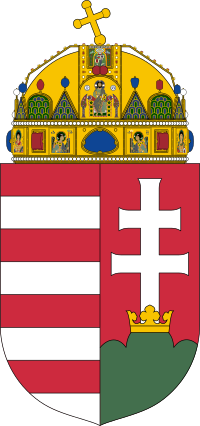Text from Wikipedia - the free encyclopædia,
unless otherwise stated.
The Cathedral and Primatial Basilica
of The Blessed Virgin Mary Assumed Into Heaven,
and Saint Adalbert, Esztergom, Hungary.
Photo: 13 August 2011.
Source: http://www.flickr.com/photos/ramoncutanda/6100881117/
Author: Ramón Cutanda López.
(Wikimedia Commons)
Coat-of-Arms of Hungary.
the second Gules, on a mount Vert a crown Or, Date: 1 January 2009.
(Wikimedia Commons)
The Primatial Basilica of The Blessed Virgin Mary Assumed Into Heaven and Saint Adalbert (
Hungarian: Nagyboldogasszony és Szent Adalbert prímási főszékesegyház), also known as The Esztergom Basilica (
Hungarian: Esztergomi bazilika), is an
Ecclesiastic Basilica in
Esztergom,
Hungary, the Mother Church of The
Archdiocese of Esztergom-Budapest, and the Seat of The Catholic Church in Hungary. It is Dedicated to
Saint Mary of The
Assumption, and
Saint Adalbert.
English: The Altarpiece of Esztergom Basilica.
Painted by Michelangelo Grigoletti. It is the biggest
Altarpiece in the world, which was painted only onto a single canvas.
Magyar: Az esztergomi bazilika oltárképe, melyet Michelangelo
Grigoletti festett. A világ legnagyobb, egy vászonra festett olajképe.
Photo: 9 September 2009.
Source: Own work.
(Wikimedia Commons)
It is the biggest building in
Hungary and the eighteenth biggest Church in the world. Its inner area is 5,600 m². It is 118 m long and 49 m wide. It has a
reverberation time of more than 9 seconds. Its Dome, forming a Semi-Sphere, is situated in the middle, and it has twelve windows. It is 71.5 m high inside, with a diameter of 33.5 metres, and is 100 m high from outside, counted from the Crypt.
The Altarpiece (13.5 × 6.6 metres, depicting The Assumption of The Blessed Virgin Mary, by
Girolamo Michelangelo Grigoletti) is the largest painting in the world painted on a single piece of canvas.
English: Esztergom Cathedral.
Magyar: Az Esztergomi Bazilika éjjel.
Photo: 21 February 2006.
Source: Own work.
(Wikimedia Commons)
The Basilica is also known as the Bakócz Chapel (named after
Tamás Bakócz), built by Italian Masters between 1506–1507, out of Red
Marble of
Süttő, its walls adorned with
Tuscan Renaissance motifs. It is the most precious remaining example of Renaissance Art in Hungary.
The huge Crypt, built in Old Egyptian Style in 1831, is today the resting place of Late Archbishops, among others,
József Mindszenty, famous for his opposition to both Nazi and Communist rule.
Photo: April 2009.
Source: Own work.
(Wikimedia Commons)
The building of the present Church took place on the Foundations of several earlier Churches. The first was built by
Stephen I of Hungary, between 1001–1010 (as the original Saint Adalbert Church), the first Cathedral in Hungary, which was burned down at the end of the 12th-Century. It was rebuilt, and even survived the Mongol invasion of Hungary. However, in 1304,
Wenceslaus III, a probable candidate for the Hungarian Throne, sacked the Castle and the Church. It was repaired in the following years.
Esztergom Basilica.
Photo: 15 June 2011.
Source: Own work.
(Wikimedia Commons)
The Archbishops, of the 14th- and 15th-Centuries, made the Church more ornate and added a huge Library, the second most significant one in the Country. It was ruined again, under Turkish rule, in 1543. In 1820, the Archdiocese was restored and Archbishop Sándor Rudnay decided to restore Esztergom's status as Mother Church of the Country. The Church maintains the Relics of the Catholic Martyr and Saint,
Marko Krizin.
The architect was
Pál Kühnel and the lead contractor was
János Packh. The Foundation-Stone was laid and work began in 1822. The Bakócz Chapel was carefully disassembled (into about 1,600 pieces) and was moved twenty metres away from its original location and attached to the new Basilica.
Coronation Chasuble.
Hungarian embroidery from the 17th-Century.
Photo: 18 February 2013.
Current location: Főszékesegyházi kincstár, Esztergom, Hungary.
Source: Own work, scanned by Szilas from A magyar Szent Korona
by Tóth Endre, Szelényi Károly, Kossuth 2000, Budapest.
(Wikimedia Commons)
In 1838, Packh was murdered, so
József Hild was placed in charge of construction. He completed it in Classic Style. Under the next Archbishop, János Scitovszky, the Upper Church was completed and Dedicated on 31 August 1856. The 1856 Consecration Ceremonies featured the premiere of the Missa Solennis zur Einweihung der Basilika in Gran (Grand Mass), composed and conducted by
Franz Liszt, and featuring the Organist
Alexander Winterberger. The final completion of the Cathedral took place twelve years later, in 1869.
English: The Organ,
Basilica in Esztergom, Hungary.
Magyar: Az esztergomi bazilika orgonája.
Photo: 9 September 2009.
Source: Own work.
(Wikimedia Commons)
The renovation and enlargement of the
Organ started in the 1980s, after extensive preparations, and it is currently in progress. It is supervised by
István Baróti, the Basilica's Organist and Choirmaster since 1975. As of 2008, the project is still not fully funded.
The Organ has five
manuals and by 2006 had 85
stops working out of the planned 146. The Organ contains the largest Organ Pipes in Hungary, 10 m, about 35 feet (11 m) long. When complete, it will be the third largest Organ in Europe, surpassing all Organs in Hungary in both volume and variety of stops.
At the time of the construction, in 1856, the Organ was the largest in Hungary with forty-nine stops, 3,530 Pipes and 3 manuals. The present Organ preserves several stops from the instrument that Liszt played.
For the Organ's detailed specifications, see
its article in the Hungarian Wikipedia.










































